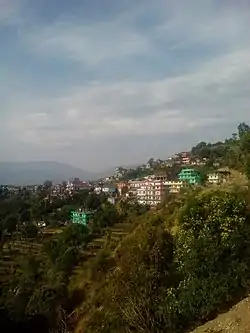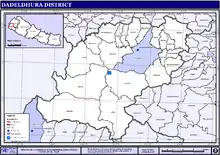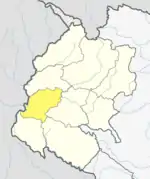Dadeldhura District
Dadeldhura, a part of Sudurpashchim Province, is one of the seventy-seven districts of Nepal. The district, with Dadeldhura as its district headquarters, covers an area of 1,538 km2 (594 sq mi) and had a population of 126,162 in 2001[4] and 142,094 in 2011.[3]
डडेल्धुरा (Dadeldhura) | |
|---|---|
| Dadeldhura District | |
 | |
| Country | Nepal |
| Province | Sudurpashchim Province |
| Admin HQ. | Amargadhi[1] |
| Government | |
| • Type | Coordination committee |
| • Body | DCC, Dadeldhura |
| • Chief District Officer | Mohan Raj Joshi [2] |
| • Administrative Officer | Hem Prasad Dhakal |
| • Elected member of House of Representative | Sher Bahadur Deuba |
| Area | |
| • Total | 1,538 km2 (594 sq mi) |
| Population (2011)[3] | |
| • Total | 142,094 |
| • Density | 92/km2 (240/sq mi) |
| Time zone | UTC+05:45 (NPT) |
| Main Language(s) | Dotyali |
| Other languages | Nepali, Magar |
The region has a mountainous landscape that contains many religious temples. The district is seldom visited by tourists but contains local routes to Mt Kailash in Tibet, Ra Ra Lake in Humla district, and the last remaining remnants of the Far Western Malla Kingdom. Nagi Malla was the last royal to live here before the Nepalese unification.
The spoken language is Doteli and the majority of inhabitants are Hindu. Dadeldhura is the most developed district among the other hilly districts in the far western region. Dadeldhura is the hometown of current prime minister of Nepal Hon. Sher Bahadur Deuba.
Geography and climate
| Climate Zone[5] | Elevation range | % of Area |
|---|---|---|
| Lower Tropical | below 300 meters (1,000 ft) | 0.6% |
| Upper Tropical | 300 to 1,000 meters 1,000 to 3,300 ft. |
34.7% |
| Subtropical | 1,000 to 2,000 meters 3,300 to 6,600 ft. |
55.8% |
| Temperate | 2,000 to 3,000 meters 6,400 to 9,800 ft. |
8.9% |
The highest temperature ever recorded in Dadeldhura was 34.3 °C (93.7 °F) on June 20, 2012, while the lowest temperature ever recorded was −5.0 °C (23.0 °F) in January 2008.[6]
| Climate data for Dadeldhura, 1980-2010 normals, extremes 1978-present | |||||||||||||
|---|---|---|---|---|---|---|---|---|---|---|---|---|---|
| Month | Jan | Feb | Mar | Apr | May | Jun | Jul | Aug | Sep | Oct | Nov | Dec | Year |
| Record high °C (°F) | 25.5 (77.9) |
25.5 (77.9) |
33.3 (91.9) |
33.5 (92.3) |
32.3 (90.1) |
34.3 (93.7) |
32.4 (90.3) |
30.1 (86.2) |
28.5 (83.3) |
28.8 (83.8) |
25.0 (77.0) |
25.0 (77.0) |
34.3 (93.7) |
| Average high °C (°F) | 14.0 (57.2) |
15.2 (59.4) |
19.4 (66.9) |
23.6 (74.5) |
26.1 (79.0) |
26.0 (78.8) |
24.2 (75.6) |
23.8 (74.8) |
23.3 (73.9) |
21.7 (71.1) |
18.5 (65.3) |
15.7 (60.3) |
20.6 (69.1) |
| Daily mean °C (°F) | 9.0 (48.2) |
10.2 (50.4) |
14.0 (57.2) |
18.0 (64.4) |
20.3 (68.5) |
21.3 (70.3) |
20.7 (69.3) |
20.4 (68.7) |
19.4 (66.9) |
16.7 (62.1) |
13.2 (55.8) |
10.5 (50.9) |
15.7 (60.3) |
| Average low °C (°F) | 4.1 (39.4) |
5.1 (41.2) |
8.6 (47.5) |
12.3 (54.1) |
14.5 (58.1) |
16.6 (61.9) |
17.3 (63.1) |
17.1 (62.8) |
15.5 (59.9) |
11.7 (53.1) |
8.0 (46.4) |
5.3 (41.5) |
10.8 (51.4) |
| Record low °C (°F) | −5.0 (23.0) |
−2.5 (27.5) |
−1.0 (30.2) |
3.0 (37.4) |
6.8 (44.2) |
7.8 (46.0) |
8.0 (46.4) |
10.8 (51.4) |
10.6 (51.1) |
1.4 (34.5) |
3.0 (37.4) |
−4.2 (24.4) |
−5.0 (23.0) |
| Average precipitation mm (inches) | 42.8 (1.69) |
62.5 (2.46) |
56.8 (2.24) |
55.1 (2.17) |
92.2 (3.63) |
171.6 (6.76) |
329.2 (12.96) |
315.9 (12.44) |
196.0 (7.72) |
44.3 (1.74) |
9.4 (0.37) |
23.0 (0.91) |
1,398.8 (55.09) |
| Source: Department Of Hydrology and Meteorology[7] | |||||||||||||
Demographics
| Census year | Pop. | ±% p.a. |
|---|---|---|
| 1981 | 86,853 | — |
| 1991 | 104,647 | +1.88% |
| 2001 | 126,162 | +1.89% |
| 2011 | 142,094 | +1.20% |
| 2021 | 139,420 | −0.19% |
| Source: Citypopulation[8] | ||
At the time of the 2011 Nepal census, Dadeldhura District had a population of 142,094.
As their first language, 92.6% spoke Doteli, 5.4% Nepali, 1.1% Magar, 0.2% Kham, 0.2% Raute, 0.1% Maithili and 0.1% other languages.[9]
Ethnicity/caste: 53.6% were Chhetri, 15.8% Hill Brahmin, 10.6% Kami, 4.5% Sarki, 3.8% Damai/Dholi, 3.6% Magar, 2.5% Thakuri, 1.8% Sanyasi/Dasnami, 1.6% Lohar, 0.9% Newar, 0.2% Badi, 0.2% other Dalit, 0.2% Raute, 0.2% Yadav, 0.1% Gurung, 0.1% Tharu, and 0.2% others.[10]
Religion: 98.9% were Hindu, 0.7% Buddhist and 0.3% Christian.[11]
Literacy: 65.0% could read and write, 2.6% could only read and 32.3% could neither read nor write.[12]
Administration
The district consists of seven municipalities, out of which two are urban municipalities and five are rural municipalities. These are as follows:[13]
- Amargadhi municipality
- Parshuram municipality
- Aalitaal Rural Municipality
- Bhageshwar Rural Municipality
- Navadurga Rural Municipality
- Ajaymeru Rural Municipality
- Ganyapadhura Rural Municipality
Former village development committees
Prior to the restructuring of the district, Dadeldhura District consisted of the following Village development committees:

See also
References
- "Amargadhi Municipality". The Government of Nepal. Retrieved 1 September 2018.
- "Staff Profile of DAO". The Government of Nepal. Retrieved 23 November 2022.
- "National Population and Housing Census 2011(National Report)" (PDF). Central Bureau of Statistics. Government of Nepal. November 2012. Archived from the original (PDF) on 18 April 2013. Retrieved 1 November 2012.
- "Nepal Census 2001". Nepal's Village Development Committees. Digital Himalaya. Archived from the original on 12 October 2008. Retrieved 12 December 2008.
- The Map of Potential Vegetation of Nepal – a forestry/agroecological/biodiversity classification system (PDF), Forest & Landscape Development and Environment Series 2-2005 and CFC-TIS Document Series No. 110., 2005, ISBN 87-7903-210-9, retrieved 22 November 2013
- "Extremes Temperatures January" (PDF). Retrieved 3 February 2021.
- "Climate Files". Department Of Hydrology and Meteorology. Retrieved 3 February 2021.
- "NEPAL: Administrative Division". www.citypopulation.de.
- NepalMap Language
- NepalMap Caste
- NepalMap Religion
- NepalMap Literacy
- "स्थानिय तह" (in Nepali). Ministry of Federal Affairs and General Administration. Archived from the original on 31 August 2018. Retrieved 1 September 2018.
- "Districts of Nepal". Statoids.
